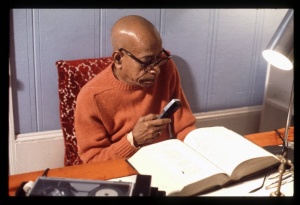SB 4.4.25

A.C. Bhaktivedanta Swami Prabhupada
TEXT 25
- kṛtvā samānāv anilau jitāsanā
- sodānam utthāpya ca nābhi-cakrataḥ
- śanair hṛdi sthāpya dhiyorasi sthitaṁ
- kaṇṭhād bhruvor madhyam aninditānayat
SYNONYMS
kṛtvā — after placing; samānau — in equilibrium; anilau — the prāṇa and apāna airs; jita-āsanā — having controlled the sitting posture; sā — Satī; udānam — the life air; utthāpya — raising; ca — and; nābhi-cakrataḥ — at the circle in the navel; śanaiḥ — gradually; hṛdi — in the heart; sthāpya — placing; dhiyā — with the intelligence; urasi — towards the pulmonary passage; sthitam — having been placed; kaṇṭhāt — through the throat; bhruvoḥ — of the eyebrows; madhyam — to the middle; aninditā — the blameless (Satī); ānayat — raised.
TRANSLATION
First of all she sat in the required sitting posture, and then she carried the life air upwards and placed it in the position of equilibrium near the navel. Then she raised her life air, mixed with intelligence, to the heart and then gradually towards the pulmonary passage and from there to between her eyebrows.
PURPORT
The yogic process is to control the air passing within the body in different places called ṣaṭ-cakra, the six circles of air circulation. The air is raised from the abdomen to the navel, from the navel to the heart, from the heart to the throat, from the throat to between the eyebrows and from between the eyebrows to the top of the cerebrum. That is the sum and substance of practicing yoga. Before practicing the real yoga system, one has to practice the sitting postures because this helps in the breathing exercises which control the airs going upwards and downwards. This is a great technique which one has to practice to attain the highest perfectional stage of yoga, but such practice is not meant for this age. No one in this age can attain the perfectional stage of such yoga, but people indulge in practicing sitting postures, which is more or less a gymnastic process. By such bodily gymnastics one may develop good circulation and may therefore keep one's body fit, but if one simply restricts oneself to that gymnastic process one cannot attain the highest perfectional stage. The yoga process, as described in the Keśava-śruti, prescribes how one can control his living force according to his desire and transmigrate from one body to another or from one place to another. In other words, yoga practice is not meant to keep the body fit. Any transcendental process of spiritual realization automatically helps one to keep the body fit, for it is the spirit soul that keeps the body always fresh. As soon as the spirit soul is out of the body, the material body immediately begins to decompose. Any spiritual process keeps the body fit without separate endeavor, but if one takes it that the ultimate aim of yoga is to maintain the body, then he is mistaken. The real perfection of yoga is elevation of the soul to a higher position or the liberation of the soul from material entanglement. Some yogīs try to elevate the soul to higher planetary systems, where the standard of life is different from that of this planet and where the material comforts, life-span and other facilities for self-realization are greater, and some yogīs endeavor to elevate the soul to the spiritual world, the spiritual Vaikuṇṭha planets. The bhakti-yoga process directly elevates the soul to the spiritual planets, where life is eternally blissful and full of knowledge; therefore bhakti-yoga is considered to be the greatest of all yoga systems.